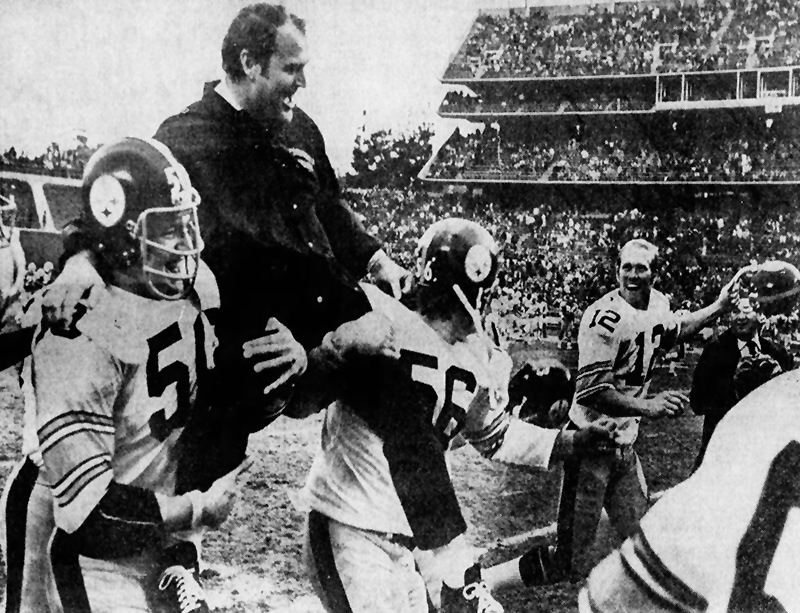Division Champions Scrub ‘SOS’ Tag
It was a long time coming, but the Steelers finally ended their football frustrations by winning their first division championship in forty years. Here is the first of a series of stories by Charley Feeney written in 1972 recalling the pitfalls – and even some of the happy times – in the team’s long climb from the basement to division champions.
Pittsburgh Press image by Al Herrmann Jr.
“Art Rooney put up with all of us. He was a forgiving man. Anybody who could forgive as much as he could, must be a fine fellow,” Byron Whizzer White, U.S. Supreme Court justice. A Steelers halfback in 1938 when they lost nine of eleven games.
“Art Rooney has been duping Steeler fans for years. Sometimes I think he didn’t want a winner in this town. If he did, why did he trade away so many good players?” – Mike Bache, a fan who has seen more than 75 percent of the Steelers home games over the forty-year period.
“People have been mighty good to me in Pittsburgh, but then they’ve given me some raspberries, and that’s all right. If I were sitting out there, I’d boo Art Rooney too,” – Art Rooney, president of the AFC Central Division champions.
The Steelers are champions… hard to believe. It’s a fact.
Thirty nine years of frustration ended Sunday in San Diego. They are no longer the “Same Old Steelers.” They are division champs and they are two victories away from going to the Super Bowl.
The phrase “Same Old Steelers” irritates Coach Chuck Noll, who, until three years ago, was not responsible for the long string of losing years.
The SOS phrase was initiated by Art Rooney, who admits he ran the team on sentiment for many years and is critical of his choice of coaches in certain eras.
Following a 2-7-2 season in 1940, Art Rooney watched the Steelers in a 1941 pre-season practice. They were wearing new uniforms. The team didn’t impress Rooney. “It’s the same old Steelers,” he announced bluntly.
Rooney, who has been known to pick horses better than he picked football players, was right. The team finished 1941 with a 1-9-1 record.
Veteran Steeler fans are aware of the frustrations. Yet the Steelers really weren’t known as losers until the mid-sixties. There were other years when enthusiasm prevailed. There were years of hope. There were years of teams that were close to championship caliber.
There was 1947 when the Steelers were tied for first place, only to lose 21-0 to the Philadelphia eagles in an Eastern Division playoff at Forbes Field.
Three years after the Steelers were born in 1933, they had a team with potential. They finished 6-6 and hopes were high for the following season. “I pulled my biggest coaching boner back in 1936,” admitted Rooney. “I let Joe Bach get away.”
Bach had coached the Steelers to a 4-8 record in 1935 before improving them to .500 in ’36.
“Bach was the Joe College type,” Rooney said. “In those days, there weren’t many fans at pro games. The colleges drew the crowds. We didn’t have any cheerleaders or anything like that. Bach loved the college game. He got a chance to coach at Niagara and I let him go. He would have stayed if I would have asked him. If he remained, I’m sure we would have had a winner with him coaching.”
Bach returned to coach the team in 1952 and ’53 with only marginal success. “Joe wasn’t healthy when he rejoined us,” Rooney said. “Losing him the first time was my fault. The second time it was just one of those things.”
The other era of hop of Rooney and Steeler fans came when Jock Sutherland coached the team in 1946 and ’47.
“If Jock had lived, he would have produced a winner,” suggested Rooney. “I’ll tell you one thing about Jock. He was the only coach in history who people paid to see. He was a drawing card. For the 1947 season, we had advance sales 22,500 at Forbes Field. Jock was responsible for that.”
Following the 1947 season, Jock Sutherland, who built a collegiate powerhouse at Pitt, died of a brain tumour.
The Steelers came close in 1963 when Buddy parker directed a Steeler into the last game with a chance at an Eastern Division title.
But the Steelers were beaten 33-17, by the Giants in New York. In a few years, the losers’ tag hung on the uniform of any player who wore the black and gold colours of the Steelers.
Article printed in the Pittsburgh Post-Gazette December 19, 1972.
